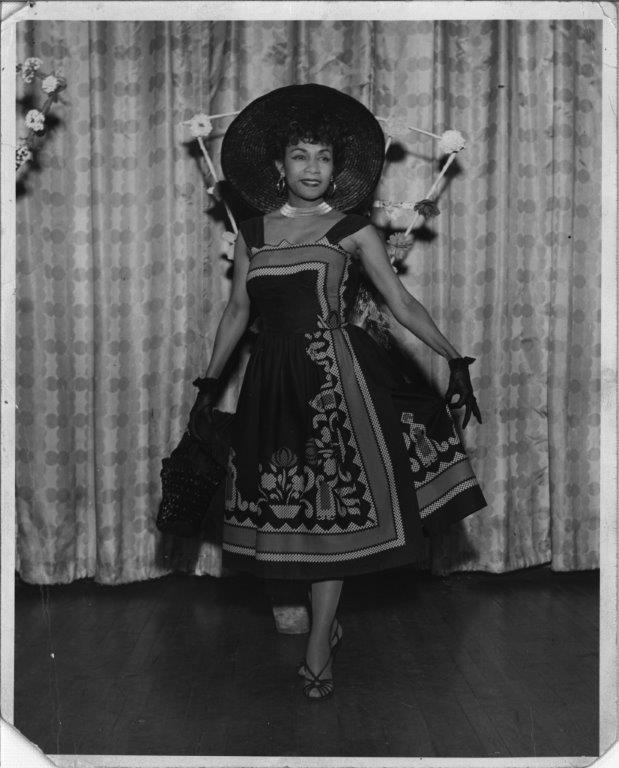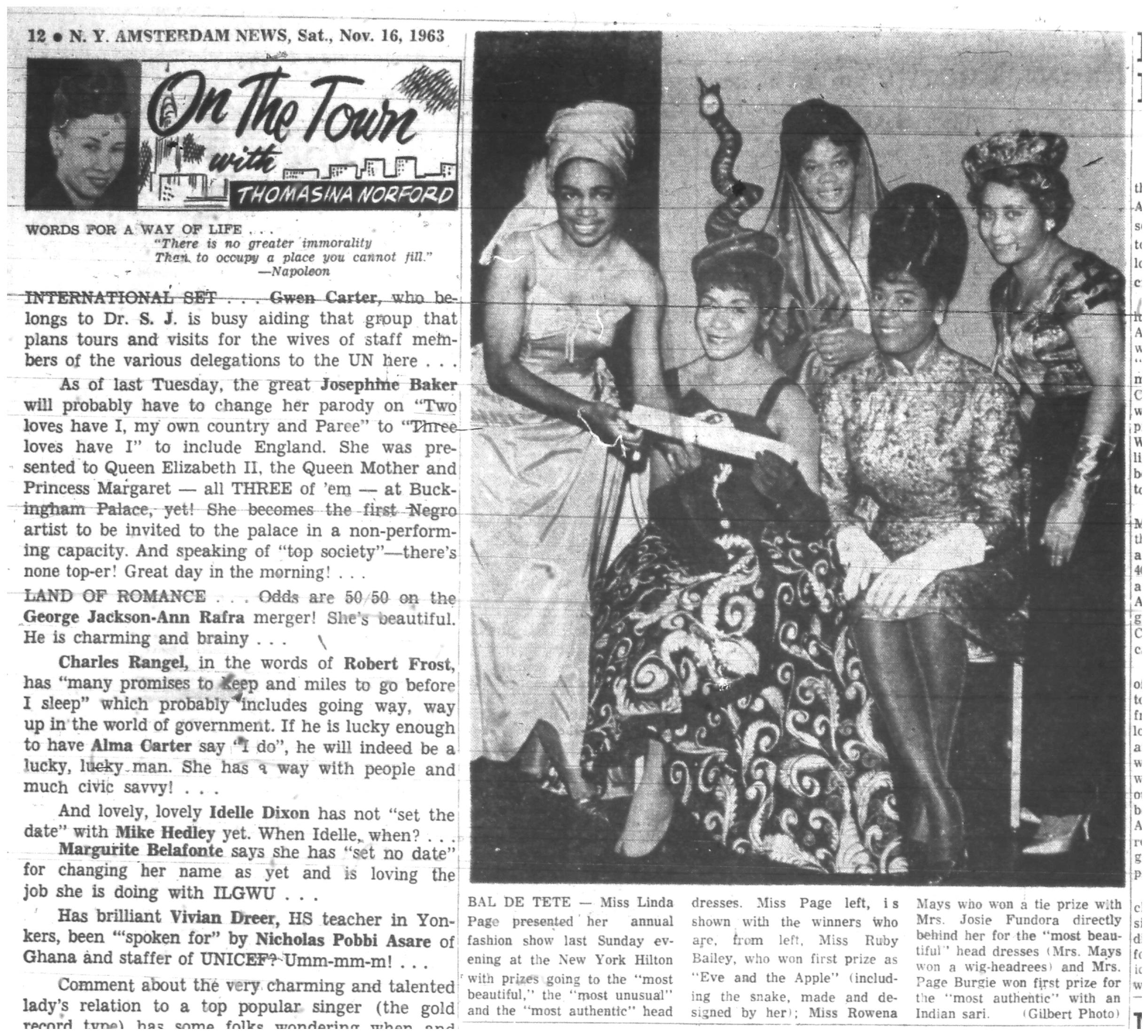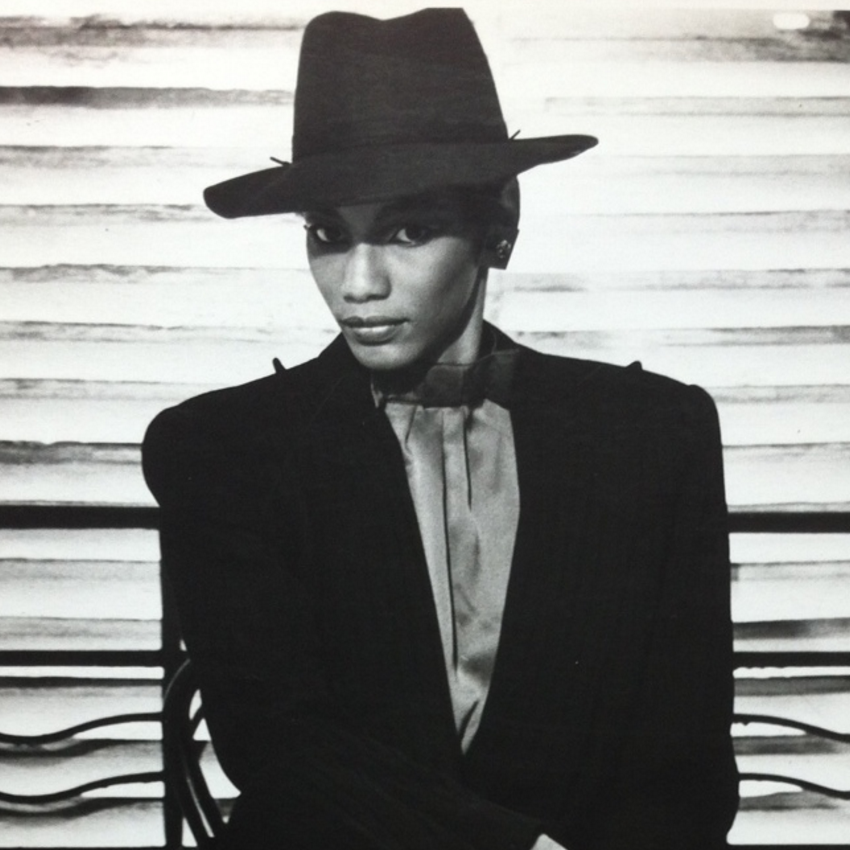The Life and Work of Ruby Bailey, Zelda Wynn Valdes, and Ann Lowe
Ruby Bailey, Zelda Wynn Valdes, and Ann Lowe were three very different designers, united by their experiences as black female designers in mid-century New York City. Despite their differing design aesthetics, they faced the same racial and gender discrimination in their efforts to make names for themselves as designers in a burgeoning fashion capital. However, these barriers were not insurmountable; all three were successful to varying degrees.
Bermuda-born Ruby Bailey—the least known and most flamboyant of the three—was what we might call today a poly-hyphenate. She was an actress, painter, and, of course, a designer. As a master beader, Bailey worked with Hollywood costume designer Adrian, but she also made a name for herself as an artist. In a two-page biographical sketch written by Bailey herself in the third person, she describes a sculpture made of cotton that was installed in the Empire Room of the Waldorf Astoria as her greatest achievement. [1]
Bailey used herself as a model, wearing her designs at Harlem hotspots like Small’s Paradise. In her own words, she “modeled her imaginative collection in fashion shows…up-town-down-town-out-of-town, while participating in a wide range of art and little theatre activities.” [2] Bailey’s creations included a black cocktail dress embroidered with jewel-encrusted spiders and bees that she wore to the “Bugs” Cotton Extravaganza at the Savoy Ballroom. Another gem plucked from her closet is the “Eve and the Apple” ensemble, which included a stuffed serpent headpiece with a bejeweled tongue and eyes, which she wore to an annual “bal de tête” fashion show at the New York Hilton in 1963. [3] Photos of her in these outfits appeared in the pages of the New York Amsterdam News, the New York Age, and other New York City-based black newspapers.
Bailey was acutely aware that pervasive racism in the fashion industry limited her success. Designing during the tumultuous Civil Rights era and coming of age in a segregated New York City, Bailey was highly race conscious, and she participated in a number of fashion shows, art exhibitions, and theatrical productions reserved for New York’s black population. She reimagined her African heritage in bold prints that expressed a nascent Afrocentricity. [4]
Bailey ran in the same circle as another black designer, Zelda Wynn Valdes. The two both lived in the epicenter of black creativity in the early twentieth-century: Harlem. Both were also members of the National Association of Fashion and Accessory Designers, which was founded by educator and activist Mary McLeod Bethune to give black designers more influence in the fashion industry.
Zelda Wynn Valdes had a high profile clientele, creating gowns and costumes for Eartha Kitt, Dorothy Dandridge, Marian Anderson, Josephine Baker, and Ella Fitzgerald. Describing her design process for Fitzgerald in a New York Times feature, Valdes said, “I only fit her once in 12 years. I had to do everything by imagination for her. She liked fancy clothes with beads and appliqués.” [4] Most famously, Valdes had a long-standing relationship with the Playboy Club of New York, and she is often credited with designing the Playboy Bunny costume. [5]
Valdes was born in Chambersburg, Pennsylvania, where she first designed for her grandmother. As an adolescent, she worked in her uncle’s tailoring shop in White Plains, New York. Shortly thereafter, she worked as the only black stock girl at a fancy retailer. Despite opposition, she moved into sales and alterations. Her talent was undeniable, and she opened her own shop on Broadway and 158th—present-day Washington Heights—and eventually moved operations downtown to 57th Street. All in all, her career spanned over 40 years. Even after closing her business, she served as head costume designer for the Dance Theater of Harlem.
Valdes and Bailey focused much of their attention on the “Negro market.” However, Ann Lowe catered to another demographic. Though she spent most of her life in Harlem like Bailey and Valdes, she designed for New Yorkers who lived in a different part of the city—the tony Upper East Side, where her stores and studio were also located. Lowe was a bit elitist regarding her clientele. She is documented as saying that she only designed for elite families, like the du Ponts, Roosevelts, Astors, and the Auchinclosses. “I love my clothes and I’m particular about who wears them. I’m not interested in sewing for café society or social climbers. I do not cater to Mary and Sue. I sew for the families of the Social Register,” she told Ebony in her 1966 feature. [6]
Lowe’s maternal grandfather “General” Cole was a free black carpenter who bought the freedom of Lowe’s grandmother, an enslaved seamstress named Georgia. The two married soon thereafter. Their daughter Janey followed the métier of her mother. Janey was Lowe’s mother. Ann Lowe was thus a third generation clothier.
Lowe was born in Alabama, where she started her business. After a few years, she participated in the Great Migration of African-Americans from the South to major metropolises in the North in pursuit of greater employment opportunities and less racial discrimination. She enrolled in a design school. In an Ebony profile, Lowe described her early years in New York City as lonely and difficult. At age 18, she was the only black student at the S. L. Taylor design school and was segregated from the other students in a separate classroom.
Lowe opened two shops of her own in the Upper East Side and even had a short-lived boutique in Saks Fifth Avenue. Her biggest claim to fame is having been the designer of the gown that Jacqueline Kennedy Onassis wore to her 1953 wedding to future president John Kennedy. Inauspiciously, a flood in Lowe’s studio destroyed the wedding dress and the gowns of the entire wedding party. She had just two weeks to remake all the dresses and ended up losing money on the order.
Although they all were successful to varying degrees, Lowe and her African-American contemporaries Zelda Wynn Valdes and Ruby Bailey were rarely described as “designers” like their white male contemporaries, such as Geoffrey Beene, Arnold Scaasi, and Bill Blass. Much like Elizabeth Keckley, who designed for Mary Todd Lincoln, these women were described variously as “dressmakers,” “modistes,” “costumers,” and “seamstresses,” but were rarely accorded the same title as men, who often could only sketch or conceptualize garments. Bailey, Valdes, and Lowe began working before the rise of the celebrity designer, when how your clothes were made mattered more than who made them. This is one reason for their success, despite rampant racial and gender prejudice in the industry. The reason these women have not entered the canon of great American designers is attributable to a number of factors, but their exclusion is mainly due to their race and gender. Thankfully, curators and fashion historians have begun to reclaim the creative genius and artistry of these three black female designers. For example, the Museum of the City of New York has featured two of Bailey’s gowns in their “Glamour, New York” and “Black Style Now” shows.
These three women were trailblazers and were on the vanguard of younger generations of black designers who cut their teeth in New York City’s fashion industry. Yet, there is still a dearth of black female designers in the fashion industry. Though designers like Tracy Reese, Carly Cushnie of Cushnie et Ochs, Stella Jean, Azède Jean-Pierre, and a handful of others can be understood as Bailey, Valdes, and Lowe’s forbearers, fashion’s racial divide—as The New York Times called it in 2015—still waits to be bridged. [8]
Notes
[1] Ruby Bailey, “Cotton Sculpture – A First: I Did It My Way.”
[2] “Bal de tete,” New York Amsterdam News, November 16, 1963, 12.
[3] David Gonzalez, “About New York: Matriarch of Dancers Sews Clothing of Delight,” The New York Times, March 23, 1994.
[4] Precious D. Lovell, “Reintroducing Ruby Bailey!”, Museum of the City of New York’s blog, accessed on September 16, 2016, https://blog.mcny.org/2016/01/05/reintroducing-ruby-bailey/
[5] Nancy Diehl, “A Profile of Zelda Wynn Valdes: Costume and Fashion Designer,” Oxford University Press’s blog, March 31st 2015, accessed on August 16, 2016, http://blog.oup.com/2015/03/costume-designer-zelda-wynn-valdes/#sthash.bXyHOhyZ.dpuf.
[6] Ann Smith, “Ann Lowe: Couturier to the Rich and Famous,” Alabama Heritage 53 (Summer 1999): 8.
[7] Gerri Major, “Dean of American Designers,” Ebony (December 1966): 135.
[8] Vanessa Friedman, “Fashion’s Racial Divide,” The New York Times, February 11, 2015.
(Photos are courtesy of the Museum of the City of New York, The Costume Institute of the Metropolitan Museum of Art, Ebony, The Library of Congress, and the Schomburg Center for Research in Black Culture.)





